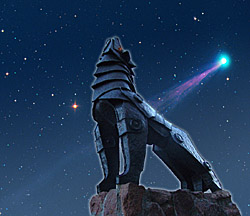
Updated 01.01.07 |
Path: Starting Page > Galleries > Lithuania > Miscellany |

Symbolics |
|
| Symbols are important to a people who have been denied free speech for so long. One of the things suppressed during
the Soviet occupation was the country’s, to say the least, tumultuous history.
Other things that were suppressed were all the symbols, not only the Christian ones. Lithuania evolved a lot during
pre-Christian times, such as the founding of the largest cities. Thus, lots of heathen symbols are still in use
today. One of the most important symbols is The Iron Wolf (Gelezinis vilkas), above. I happened to find this metal wolf at Kernave, the location of Lithuania’s first royal castle, built by king Mindaugas. Well, it didn’t look exactly like this. Just imagine what a little Photoshop can do. Legend has it that Grand Duke Gediminas was out hunting in the forest, and in the night he dreamt about a wolf, standing, howling on top of a hill. The wolf was made of iron. He asked his interpreter of dreams about the it, who explained to him that the wolf meant he must build a city. It being made of iron, meant that the city must be strongly fortified. Gediminas liked the idea and built Vilnius around he hill on which the ruins of the third castle, “the high castle” still stand. The only part that is more or less intact, and visible from street-level, is Gediminas’ Tower, an octagonal tower having three (originally four) stories. Below is a concentrate of all the important symbols you might encounter in Lithuania. |
|
| Three plaques, actually enlargements of three medals issued at the 650:th anniversary of the City of Vilnius in
1973. You were out of luck if you had these, and the KGB found you out. The Gediminas Plaque The plaque depicts Grand Duke Gediminas holding a sword. Around the plaque you read D.L.K. GEDIMINAS VILNIAUS IKUREJAS (Lithuanian Grand Duke Gediminas, founder of Vilnius). On Gediminas’ chest is the Gedimino stulpai. To the left of Gediminas is the Vytis symbol. To the right is the year of Vilnius’ foundation: 1323. |
|
| The Vilnius Plaque In the middle is the three-floor Gediminas Tower, with the third floor symbolised by the number 650, the city’s age. In front of the tower is some sort of sorcerer. To the left is a fire symbolising the pagan fire-cult, displaying the text AB. CONDITA (lat. Anno ab urbe condita) meaning “years after the city’s foundation“ i.e., the city’s age, 1323-1973 visible around the plaque. At the top of the tower is the Iron Wolf, and behind him a flagpole with a flag displaying the Gedimino stulpai. |
|
| The Vytautas Plaque In the middle is king Vytautas, with a royal crown to symbolise his royal power. Around him rages the battle of Zalgris (Grünewald) where he finally finished off the crusaders. Around the plaque you read VYTAUTAS DIDYSIS (Vytautas the Great), and the years 1430-1930, symbolising the 500:th anniversary of his death. King Vytautas turned the country into a superpower, stretching from the Baltic Sea to the Black Sea (facts that the Soviets rather would have erased). He can also pride himself of having christened the country, if only to finally get rid of the attacking crusaders. He never entered into any covenant with them. Of course, no one knows what Vytautas actually looked like. Maybe he looked like this. Maybe he looked like on painting 001 at the Lithuanian Fine Arts Museum. |
|
| The Vytis Sign, the State Emblem Vytis, the pursuer, a white knight riding leftwards is one of Europe’s oldest coat of arms. The sign was originally found on an old coin. You can find Vytis more or less anywhere, but one of the most prominent places is on the roof of the presidential palace, and on the outside of the old city gate Ausros Vartai in Vilnius. |
|
|
|
The flag, ratified on September 1, 2004, with the proportions 3:5. The yellow field is the sun shining over Lithuania. The green is for Lithuania’s green pastures, and the red is for the blood spilled for the country. |
|
|
Gedimino stulpai (Gediminas’ poles). The symbol of Lithuania, believed to have been used since the early 14:th century. |
When you travel to Lithuania there are a few things to look out for, to make your visit perfect.
Unfortunately, everything is not sunshine in Lithuania, although this probably goes for most countries. Here are a few things that Lithuania should discontinue to fully succeed in the tourist trade:
My hovercraft is full of eels = Mano laivas ant oro pagalves pilnas unguriu
There will be more general information as soon as I can find it.